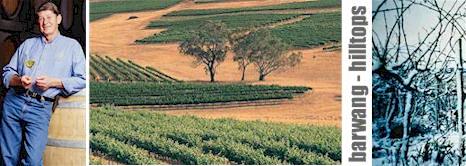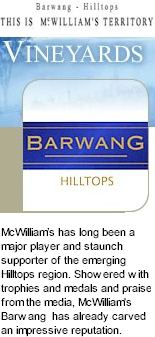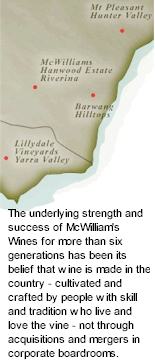


Hilltops enjoys adequate and reliable rainfall, with mild days and cool nights, allowing for the slow, even ripening of fruit. The region’s high altitude, cool prevailing winds from the Great Dividing Range which offset diurnal temperatures, and the high minerality of the soil are three significant elements which combine to make the Hilltops a distinctive wine producing region. A dry summer and autumn, with cool nights and mild days exacerbate the extended ripening period. Heavy snowfall and frost in winter are quite common; and whilst substantial rainfall occurs in the growing season, most falls in spring.

The soils are deep red, decomposed granite clays impregnated with basalt. The microclimates and terroir around Barwang Vineyard dictate regional characteristics, and act as a natural protection from the warm inland summer, reducing the risk of heat stress. The result is ideal growing conditions for making premium red wine: grapes achieving maximum ripeness, ideal acid, flavour and colour retention, and intense dark fruit characters. As a safeguard against drought conditions, a massive 100 million litre dam has been built, capable of delivering 120,000 litres of water per hour to twelve zones on the vineyard. During vintage, grapes are crushed on site at Barwang and the juice transported by insulated tanker to McWilliam's winemaking headquarters at Yenda, near Griffith in New South Wales.
McWilliam’s has long been a major player and staunch supporter of the emerging Hilltops region. Peter Robinson, a local farmer and former RAAF fighter pilot established the then 13 hectare vineyard in 1969 using vine cuttings procured from the McWilliam family. Exactly 20 years later the vineyard was purchased by McWilliam's and progressively expanded to its current 100 hectares. Redeveloped over the course of a decade, the site is currently planted to Cabernet Sauvignon (30 hectares), Shiraz (30 hectares), Chardonnay (18 hectares) and Merlot (nine hectares), with smaller parcels of Semillon, Pinot Noir, Sauvignon Blanc and Riesling.
The climate is often likened to Southern Rhone in France, it is no surprise Barwang produces distinctive spicy, peppery Shiraz. The fruit attains physical ripeness at the higher end of the sugar spectrum, achieving flavour intensity without stewed or porty characters. The finished wine also benefits from components of fruit sourced from vines on the Barwang vineyard which are more than thirty years old. In keeping with its European counterpart, French oak, predominantly Vosges, is used with Barwang Shiraz to add length while imparting a slight austerity to ensure the wine’s cellaring potential. Barwang Shiraz as full flavoured with savoury and spicy blood plum fruit flavours and refined, integrated nutmeg and pencil shavings oak characters.

The Barwang Cabernet Sauvignon and Shiraz undergo barrel fermentation, enabling better integration of fruit and oak, adding another layer of complexity to the final wines. The dynamics of yeast, oak and oxygen gave a third dimension to the wines, a savoury edge, which is something that the winemakers seek to achieve with Barwang reds. Barwang Cabernet Sauvignon is a distinctive wine, displaying intense dark berry fruit and blueberry conserve flavours, rather than the typical minty and cassis Cabernet characters found in other regions.
McWilliam's truly sets the benchmark for Barwang in terms of yields, quality and the expression of the unique regional flavours. In 2001 the Hilltops region was 2.3°C cooler than the mean January temperature (22.9°C). Cooler conditions as well as reduced yields, produce fruit with more pronounced regional and varietal characters. These factors in turn influence the winemaking decisions. For the reds, reduced oak tannins are brought about by the introduction of larger format oak, allowing for better fruit expression. The Hilltops and Tumbarumba regions have long been pioneers of new and exciting wine styles in Australia. The McWilliams vvineyards here have established a leading edge in the continuing evolution of high-grown styles, with the release of the new styles to the Barwang range.
McWilliam’s outstanding success at the 2006 Canberra Regional Wine Show secured for the estate Most Successful Exhibitor of Show Trophy. Every wine entered by McWilliam’s Barwang collected a medal. This accolade marks McWilliam’s fourth Most Successful trophy for this year at wine shows across Australia. McWilliam’s Barwang led the charge, collecting a trophy and three gold medals. Barwang Cabernet has always been well received by media and consistently awarded at shows across the country. This medal again confirmed the excellent quality and continuity of this wine. Since the 1996 vintage, Barwang Cabernet Sauvignon has been awarded a total of two trophies and 17 gold medals, with every vintage collecting at least one gold medal. Also garnering gold from the Canberra Regional Wine Show haul was the highly anticipated 2004 Barwang Shiraz Viognier. Another winner was the 2005 Barwang Tumbarumba Chardonnay, a new style for the range which collected a trophy and gold medal at the wine show.
The addition of a Merlot to the Barwang range is an indication of the confidence in quality and consistency of red fruit available from the Hilltops district. After years of trial and experimentation, reliable and continuing supplies of excellent quality Merlot are flowing from the Barwang Vineyard. The wine displays rich primary fruit flavours and distinctive ripe blackberry characters that have become the hallmarks of red wines from the Hilltops district. The Merlot vines were originally planted in 1991, and are now of sufficient maturity to meet the high standard set for wines which carry the Barwang label.
